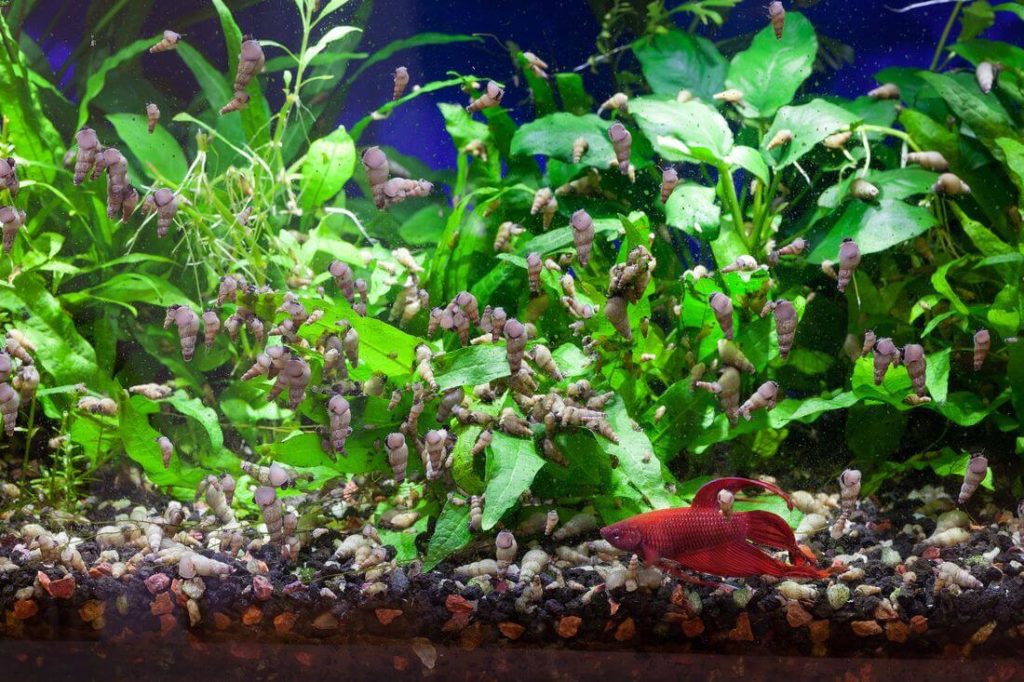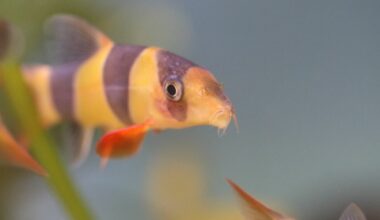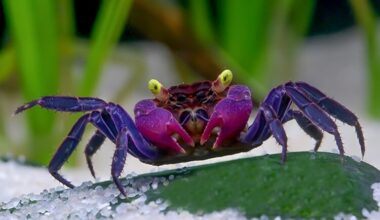Malaysian trumpet snails are interesting little critters that more and more aquarists are starting to intentionally keep in their tanks. While not one of the traditional snail choices, this species still has a lot to offer!
This guide will teach you all about these wonderful tiny creatures, and how to successfully keep them in your home aquarium.
Let’s get started!
Table of Contents
Species Summary
Malaysian trumpet snails (scientific name: Melanoides tuberculata) are a common sight in aquarists around the world! These highly adaptable creatures can thrive in just about any aquarium setup. Hardy and undemanding, they are perfect for novice snail owners or any aquarist looking for a unique invert to add to their tank.
In the wild, the distribution of the Malaysian trumpet snail is vast. It’s found in Asia, Africa, the Middle East, and more. While they prefer freshwater environments, these critters have been found in brackish environments, too.
Oftentimes, aquarists view these snails as stubborn pests. But in the right conditions, they can be a useful pet that benefits your tank.
Why Keep Them as Pets?
It’s not hard to see why many seasoned aquarists hate Malaysian trumpet snails. Without proper management, they can overpopulate the tank and create a significant bioload.
So, why keep them as pets?
Well, Malaysian trumpet snails can improve the overall quality and state of the tank. For one, they can keep the tank clean. The snail’s natural diet consists of algae, plant detritus, and tons of other food sources that can sour the water quality.

These aquarium snails burrow into the substrate to feed on everything from decaying plant matter to leftover food. While you can’t rely on snails alone to keep your tank clean, they can have a big positive impact.
Another big advantage of keeping Malaysian trumpet snails is their ability to keep the substrate aerated. Burrowing behavior prevents gas buildup, which does a lot to avoid sudden water toxicity. On top of that, the added aeration can improve plant growth.
The presence of these trumpet snails can do a lot to improve your freshwater tank. In smaller and more manageable numbers, they can stay out of sight while the rest of your fish benefit from their work!
Appearance
When you do see them, Malaysian trumpet snails are actually quite beautiful! They’re sporting a conical shell that can take on a wide range of colors.
Typically, shells have shades of brown, gray, and cream. You might see solidly colored shells or unique patterns. These snails have a lot of variety, which makes for an interesting addition to the tank.
Author Note: The conical shells grow in rings from the apex. These rings provide a rougher texture, which is often visible with unique coloration.
The flesh of the snail has just as much variety as the shell. Usually, the skin is lighter in color with splotches of brown or gray for accents.
At the opening of the shell, Malaysian trumpet snails have an operculum. It’s a small trap door they can use to stay safe from any dangers in their environment.
Lifespan
On average, Malaysian trumpet snails only have a lifespan of about a year. They can live longer in the right conditions, but those instances are rare.
Of course, there are no guarantees. Many factors, such as water conditions and the availability of quality food, can make a noticeable impact on their life expectancy. With that being said, there’s only so long you can expect these critters to live.
Average Size
Most of the Malaysian trumpet snails you’ll see will measure around a quarter of an inch to half an inch in length. However, these inverts are capable of growing to a full inch long in the right conditions.
Author Note: Measurements reflect the distance from the apex of the shell to the opening. Females tend to be a bit bigger than males. Though, this difference is subtle.
Malaysian Trumpet Snail Care
Malaysian trumpet snail care is a no-brainer! They’re one of the easiest aquatic creatures to own. Thanks to their hardy nature, most have no problem thriving in captivity.
But like any other animal, these snails do have optimal conditions that will allow them to thrive. Below are some important care guidelines you should know.
Tank Size
One of the best things about Malaysian trumpet snails is that they don’t need a ton of space. A small group can live in a 5 to 10 gallon tank just fine!
Author Note: It’s important to be careful about overpopulation with these snails. Overstocked freshwater aquariums can cause serious problems with ammonia and nitrates.
Water Parameters
Malaysian trumpet snails can adapt to a wide range of water conditions. Even in the wild, these snails aren’t particular to one specific environment. As long as the water is clean, aerated, and warm, they will make due!
Stick to these parameters for the best results.
- Water temperature: 65 to 86 degrees Fahrenheit (70 to 78 degrees is best)
- pH levels: 6.5 to 8.0 (aim for neutral water)
- Water hardness: 6 to 15 KH
Author Note: Make sure you invest in a high-quality water test kit to make sure that you’re getting accurate readings throughout the week. While these creatures are not picky, it’s still best if you keep their core water parameters consistent.
What To Put In Their Tank
These snails are most prevalent in bodies of water that are teeming with life. They’re attracted to food waste and decaying plants. In captivity, they prefer similar living conditions.
The most important thing you’ll need is a layer of a sand substrate. Malaysian trumpet snails are big diggers. They utilize their pointed shells to make their way through fine sand in search of food.

Gravel, pebbles, or any other hard substrate will not facilitate their burrowing behavior. Instead, those materials will harm the shell and cause injury.
Next, add live plants. these trumpet snails will not damage plants. However, they will consume any bits that fall off and decay. Avoid using any fertilization products or plant nutrients. Chemical additives can harm the snails.
As for equipment, sponge filters are a must. These snails are small enough to get sucked up into a standard filtration system. You need sponge filters to ensure that your snails do not suffer that fate.
Author Note: Also, make sure that the outlet of the filter is relatively weak. Malaysian trumpets are not strong enough to fight back against strong currents!
Common Potential Diseases
The biggest health issues that plague Malaysian trumpet snails are parasites. They can host Centrocestus formosanus, which is a parasitic worm. While unlikely to spread to humans, this parasite can affect birds and small animals.
That said, these snails can also host one parasite that will affect humans. They are intermediate hosts to parasitic lungworms that could spread to humans if you’re not careful.
Parasites are hard to treat, so it’s important to quarantine any new additions to your tank. This will allow you to quickly identify health problems without negatively impacting the rest of the life in your main tank. Also, avoid purchasing any snails that look unwell (or come from inexperienced or untrustworthy sellers).
Food & Diet
As mentioned earlier, Malaysian trumpet snails will eat a wide range of foods. These inverts are highly opportunistic and will spend most of the day looking for algae to eat as well as plant detritus and various other snacks.
During the day, they burrow underneath the substrate to eat. Once the lights go out, they may emerge to feed on soft algae that are growing on the glass or decor.
You can supplement their natural diet with things like algae wafers and pellets. However, most aquarists don’t go to that much trouble ensuring they are well-fed. The snails will find food sources and eat any leftover fish flakes that fall to the substrate.
Author Note: If you want to ensure that your snails are getting all the nutrients they need, provide a couple of vegetables or mineral blocks. They need a good source of calcium to ensure that their shells stay strong.
Tank Mates
Malaysian trumpet snails are very shy and docile. They’re not going to cause any trouble with tank mates. However, the same can’t be said for hungry fish and predatory inverts (like the assassin snail).
If you want your population to flourish, avoid any aggressive tank mates.
These snails do well with many other snail species. They also have a symbiotic relationship with many shrimp. The shrimp consume the snail’s waste, which reduces the overall bioload on the tank.
Here are some good tank mate options for the Malaysian trumpet snail.
- Nerite Snails
- Mystery Snails
- Ivory Snails
- Freshwater Clams
- Cherry Shrimp
- Bamboo Shrimp
- Vampire Shrimp
- Amano Shrimp
- Ghost Shrimp
- Cory Catfish
- Otocinclus
Breeding
Breeding is never an issue with Malaysian trumpet snails. In fact, it’s one of the biggest downsides of this aquatic creature!

Malaysian trumpet snails reproduce quickly and often. Oftentimes, overpopulation will occur if there are too many food sources available. Because of this, you have to be careful to prevent these snails from taking over.
Interestingly enough, these trumpet snails are not hermaphrodites. Males and females will mate to produce offspring. Alternatively, they can reproduce through parthenogenesis, which is when females produce tiny clones without male fertilization.
These snails are livebearers. Females can give birth to as many as 70 snails at once. At birth, they’re about the size of a grain of sand. But, they quickly grow and reach maturity within a matter of months.
Conclusion
While Malaysian trumpet snails might seem like an odd pet choice, they really make a lot of sense! As long as you can keep their population under control, these critters will do a great job of cleaning and maintaining your freshwater aquarium.
If you have questions about keeping this species under control (or anything else), don’t hesitate to reach out. We love connecting with our readers and lending a helping hand whenever we can!

